10.8 Oxidation and Reduction in Organic Chemistry
We’ve pointed out on several occasions that some of the reactions discussed in this and earlier chapters are either oxidations or reductions. As noted in Section 8.7, an organic oxidation results in a loss of electron density by carbon, caused either by bond formation between carbon and a more electronegative atom (usually O, N, or a halogen) or by bond- breaking between carbon and a less electronegative atom (usually H). Conversely, an organic reduction results in a gain of electron density by carbon, caused either by bond formation between carbon and a less electronegative atom or by bond-breaking between carbon and a more electronegative atom (Section 8.6).

Based on these definitions, the chlorination reaction of methane to yield chloromethane is an oxidation because a C−H bond is broken and a C−Cl bond is formed. The conversion of an alkyl chloride to an alkane via a Grignard reagent followed by protonation is a reduction, however, because a C−Cl bond is broken and a C−H bond is formed.
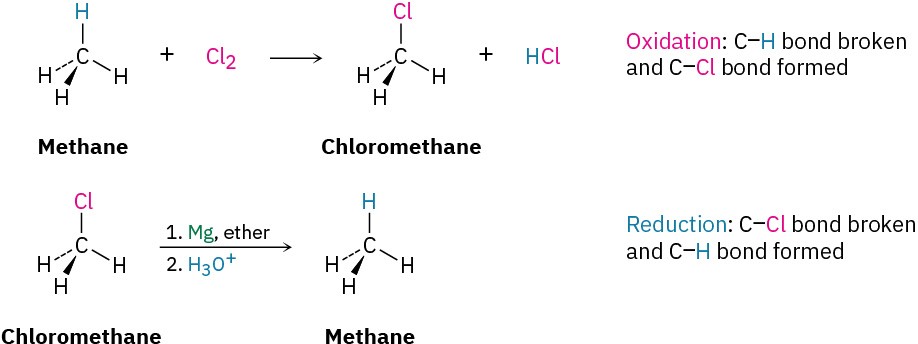
As other examples, the reaction of an alkene with Br2 to yield a 1,2-dibromide is an oxidation because two C−Br bonds are formed, but the reaction of an alkene with HBr to yield an alkyl bromide is neither an oxidation nor a reduction because both a C−H and a C−Br bond are formed.
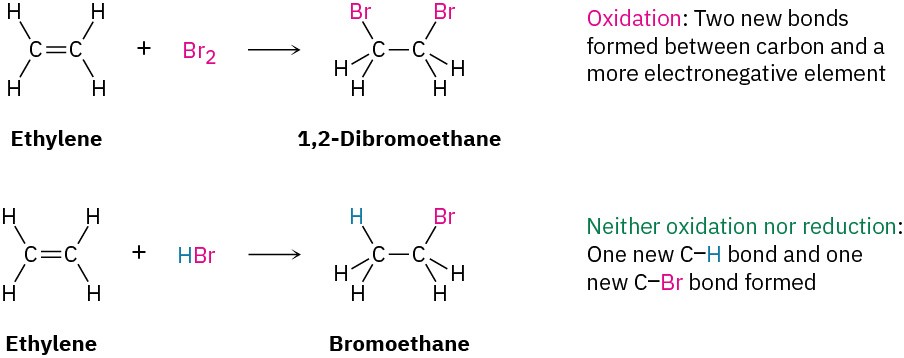
A list of compounds of increasing oxidation level is shown in Figure 10.7. Alkanes are at the lowest oxidation level because they have the maximum possible number of C−H bonds per carbon, and CO2 is at the highest level because it has the maximum possible number of C−O bonds per carbon. Any reaction that converts a compound from a lower level to a higher level is an oxidation, any reaction that converts a compound from a higher level to a lower level is a reduction, and any reaction that doesn’t change the level is neither an oxidation nor a reduction.

Figure 10.7Oxidation levels of some common compounds.
Worked Example 10.2 shows how to compare the oxidation levels of different compounds with the same number of carbon atoms.
Worked Example 10.2Comparing Oxidation LevelsRank the following compounds in order of increasing oxidation level:
 StrategyCompounds that have the same number of carbon atoms can be compared by adding the number of C−O, C−N, and C−X bonds in each and then subtracting the number of C−H bonds. The larger the resultant value, the higher the oxidation level.SolutionThe first compound (propene) has six C−H bonds, giving an oxidation level of −6; the second (2-propanol) has one C−O bond and seven C−H bonds, giving an oxidation level of−6; the third (acetone) has two C−O bonds and six C−H bonds, giving an oxidation level of
StrategyCompounds that have the same number of carbon atoms can be compared by adding the number of C−O, C−N, and C−X bonds in each and then subtracting the number of C−H bonds. The larger the resultant value, the higher the oxidation level.SolutionThe first compound (propene) has six C−H bonds, giving an oxidation level of −6; the second (2-propanol) has one C−O bond and seven C−H bonds, giving an oxidation level of−6; the third (acetone) has two C−O bonds and six C−H bonds, giving an oxidation level of
−4; and the fourth (propane) has eight C−H bonds, giving an oxidation level of −8. Thus, the order of increasing oxidation level is

Problem 10-12
Rank both sets of compounds in order of increasing oxidation level: (a)

(b)

Problem 10-13
Tell whether each of the following reactions is an oxidation, a reduction, or neither. (a)

(b)

Additional Problems 10 • Additional Problems 10 • Additional Problems Visualizing Chemistry Problem 10-14
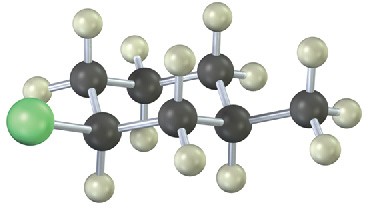 Give IUPAC names for the following alkyl halides (green = Cl): (a)
Give IUPAC names for the following alkyl halides (green = Cl): (a)
(b)
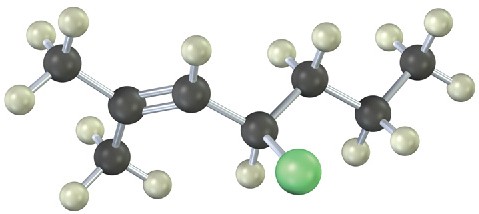
Problem 10-15
Show the product(s) of reaction of the following alkenes with NBS: (a)
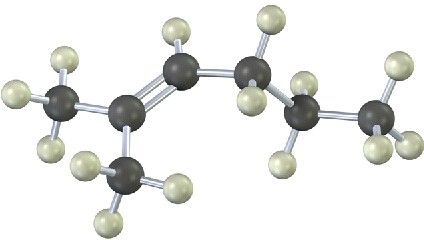
(b)

Problem 10-16
The following alkyl bromide can be prepared by reaction of the alcohol (S)-2-pentanol with PBr3. Name the compound, assign (R) or (S) stereochemistry, and tell whether the reaction of the alcohol results in the same stereochemistry or a change in stereochemistry (reddish brown = Br).
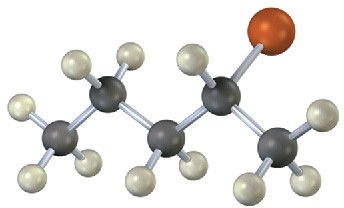
Mechanism Problems
Problem 10-17
In light of the fact that tertiary alkyl halides undergo spontaneous dissociation to yield a carbocation plus halide ion (see Problem 10-41), propose a mechanism for the following reaction.

Naming Alkyl Halides
Problem 10-18
Name the following alkyl halides:
(a)

(b)

(c)
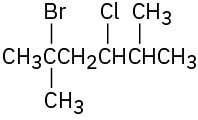
(d)

(e)

Problem 10-19
Draw structures corresponding to the following IUPAC names:
(a)
2,3-Dichloro-4-methylhexane (b)
4-Bromo-4-ethyl-2-methylhexane (c)
3-Iodo-2,2,4,4-tetramethylpentane (d)
cis-1-Bromo-2-ethylcyclopentane Problem 10-20
Draw and name all the monochlorination products you might obtain from radical chlorination of the following compounds. Which of the products are chiral? Are any of the products optically active?
(a)
- methylbutane (b)
methylcyclopropane (c)
2,2-dimethylpentane Synthesizing Alkyl Halides Problem 10-21
How would you prepare the following compounds, starting with cyclopentene and any other reagents needed?
(a) Chlorocyclopentane (b) Methylcyclopentane (c)
- Bromocyclopentene (d)
Cyclopentanol (e)
Cyclopentylcyclopentane (f)
1,3-Cyclopentadiene Problem 10-22
Predict the product(s) of the following reactions: (a)
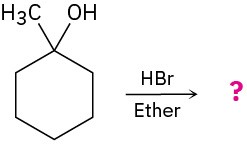
(b)

(c)

(d)
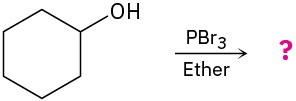
(e)

(f)

(g)

Problem 10-23
A chemist requires a large amount of 1-bromo-2-pentene as starting material for a synthesis and decides to carry out an NBS allylic bromination reaction. What is wrong with the following synthesis plan? What side products would form in addition to the desired product?

Problem 10-24
What product(s) would you expect from the reaction of 1-methylcyclohexene with NBS? Would you use this reaction as part of a synthesis?

Problem 10-25
What product(s) would you expect from the reaction of 1,4-hexadiene with NBS? What is the structure of the most stable radical intermediate?
Problem 10-26
What product would you expect from the reaction of 1-phenyl-2-butene with NBS? Explain.

Oxidation and Reduction
Problem 10-27
Rank the compounds in each of the following series in order of increasing oxidation level: (a)

(b)

Problem 10-28
Which of the following compounds have the same oxidation level, and which have different levels?

Problem 10-29
Tell whether each of the following reactions is an oxidation, a reduction, or neither: (a)

(b)

(c)

General Problems
Problem 10-30
Arrange the following radicals from most stable to least stable.
(a)

(b)

(c)

Problem 10-31
Alkylbenzenes such as toluene (methylbenzene) react with NBS to give products in which bromine substitution has occurred at the position next to the aromatic ring (the benzylic position). Explain, based on the bond dissociation energies in Table 6.3.

Problem 10-32
Draw resonance structures for the benzyl radical, C6H5CH2·, the intermediate produced in the NBS bromination reaction of toluene (Problem 10-31).
Problem 10-33
Draw resonance structures for the following species:
(a)

(b)

(c)

Problem 10-34
(S)-3-Methylhexane undergoes radical bromination to yield optically inactive 3-bromo-3- methylhexane as the major product. Is the product chiral? What conclusions can you draw about the radical intermediate?
Problem 10-35
Assume that you have carried out a radical chlorination reaction on (R)-2-chloropentane and have isolated (in low yield) 2,4-dichloropentane. How many stereoisomers of the product are formed, and in what ratio? Are any of the isomers optically active? (See Problem 10-34.)
Problem 10-36
How would you carry out the following syntheses?

Problem 10-37
The syntheses shown here are unlikely to occur as written. What is wrong with each? (a)

(b)
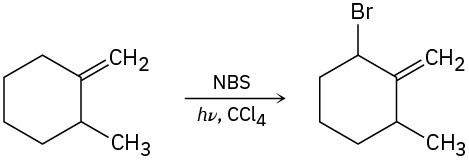
(c)
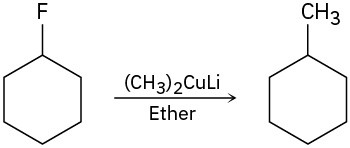
Problem 10-38
Why do you suppose it’s not possible to prepare a Grignard reagent from a bromo alcohol such as 4-bromo-1-pentanol? Give another example of a molecule that is unlikely to form a Grignard reagent.

Problem 10-39
Addition of HBr to a double bond with an ether (−OR) substituent occurs regiospecifically to give a product in which the −Br and −OR are bonded to the same carbon. Draw the two
possible carbocation intermediates in this electrophilic addition reaction, and explain using resonance why the observed product is formed.

Problem 10-40
Identify the reagents a–c in the following scheme:

Problem 10-41
Tertiary alkyl halides, R3CX, undergo spontaneous dissociation to yield a carbocation, R3C+, plus halide ion. Which do you think reacts faster, (CH3)3CBr or H2C=CHC(CH3)2Br? Explain.
Problem 10-42
Carboxylic acids (RCO2H; pKa ≈ 5) are approximately 1011 times more acidic than alcohols (ROH; pKa ≈ 16). In other words, a carboxylate ion (RCO2−) is more stable than an alkoxide ion (RO−). Explain, using resonance.
Problem 10-43
How might you use a Suzuki–Miyaura reaction to prepare the biaryl compounds below? In each case, show the two potential reaction partners.
(a)
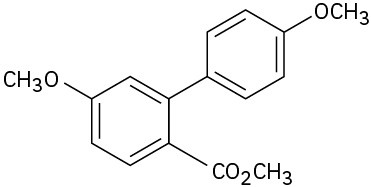
(b)
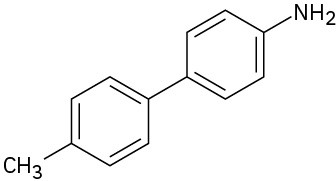
(c)
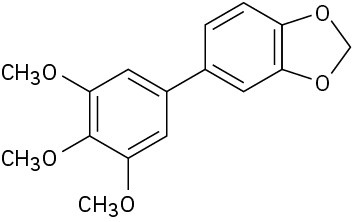
Problem 10-44
The relative rate of radical bromination is 1 : 82 : 1640 for 1° : 2° : 3° hydrogens, respectively. Draw all of the monobrominated products that you might obtain from the radical bromination of the compounds below. Calculate the relative percentage of each.
(a) methylcyclobutane (b)
3,3-dimethylpentane (c)
3-methylpentane Problem 10-45
Choose the alcohol from each pair below that would react faster with HX to form the corresponding alkyl halide.
(a)

(b)
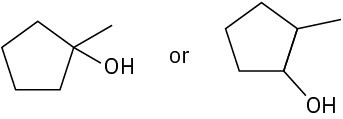
(c)

Problem 10-46
Predict the product and provide the entire catalytic cycle for the following Suzuki–Miyaura reactions.
(a)

(b)


